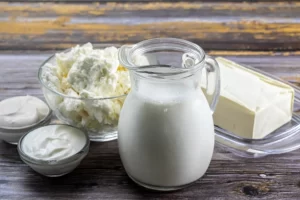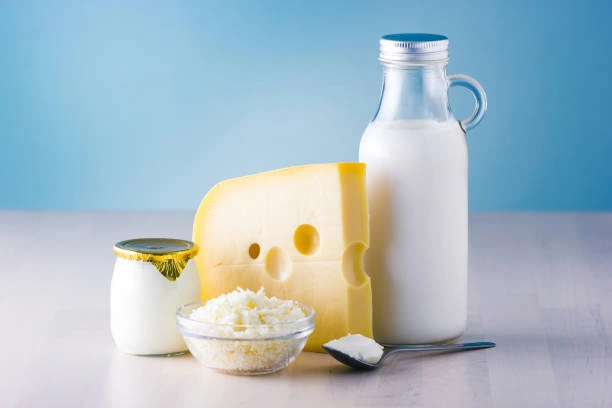Dairy products are a staple in many diets around the world, offering essential nutrients such as calcium, protein, and vitamins. However, due to their perishable nature, proper storage and handling are crucial to maintaining their freshness and safety. This guide provides comprehensive strategies for preserving various dairy products to ensure they remain fresh and safe for consumption.

Understanding Dairy Product Shelf Life
Different dairy products have varying shelf lives. Understanding these timelines can help in planning purchases and storage effectively.
1. Milk
- Unopened Pasteurized Milk: Typically lasts 5-7 days beyond the sell-by date when refrigerated.
- Opened Pasteurized Milk: Should be consumed within 3-5 days.
- Raw Milk: Has a shorter shelf life and should be consumed within 7 days of purchase.
2. Cheese
- Soft Cheeses (e.g., Brie, Camembert): Lasts 1-2 weeks after opening.
- Hard Cheeses (e.g., Cheddar, Parmesan): Can last 3-4 weeks after opening, sometimes longer if properly stored.
- Processed Cheese: Usually lasts 3-4 weeks after opening.
3. Yogurt
- Unopened Yogurt: Typically lasts 1-2 weeks beyond the sell-by date.
- Opened Yogurt: Should be consumed within 5-7 days.
4. Butter
- Unopened Butter: Can last 1-2 months in the refrigerator.
- Opened Butter: Should be consumed within 1 month for optimal freshness.
5. Cream
- Unopened Cream: Lasts 1-2 weeks beyond the sell-by date.
- Opened Cream: Should be used within 7 days.

Proper Storage Techniques
1. Refrigeration
Refrigeration is the primary method for preserving dairy products. Maintaining a consistent temperature below 40°F (4°C) is crucial.
- Milk: Store on the refrigerator shelf rather than the door to keep it at a more consistent, colder temperature.
- Cheese: Wrap in wax paper or cheese paper before placing in a plastic bag or container. This allows the cheese to breathe while retaining moisture.
- Yogurt: Keep in its original container or transfer to an airtight container.
- Butter: Store in the original wrapper or a butter dish with a lid to prevent absorption of refrigerator odors.
- Cream: Store in its original container, ensuring the lid is tightly sealed.
2. Freezing
Freezing can extend the shelf life of many dairy products, although some may experience texture changes upon thawing.
- Milk: Can be frozen for up to 3 months. Thaw in the refrigerator and shake well before use to re-incorporate any separated components.
- Cheese: Hard cheeses freeze well for up to 6 months. Grate before freezing for easier use. Soft cheeses do not freeze well due to texture changes.
- Yogurt: Can be frozen for 1-2 months. Thaw in the refrigerator and stir well before use.
- Butter: Freezes well for up to 6 months. Store in its original packaging or wrap tightly in aluminum foil and place in a freezer bag.
- Cream: Can be frozen for up to 2 months, though it may separate. Thaw in the refrigerator and whisk to re-emulsify.

Special Considerations for Different Dairy Products
1. Milk
- Extended Shelf-Life Milk: Ultra-pasteurized milk has a longer shelf life, often up to several weeks unopened. Once opened, it should be consumed within 7-10 days.
- Lactose-Free Milk: Has similar storage guidelines to regular milk. However, it tends to spoil more rapidly once opened.
2. Cheese
- Mold: On hard cheeses, mold can be cut off about an inch around the affected area. Soft cheeses with mold should be discarded.
- Cheese Rind: Natural rinds on cheese can help preserve the interior. If the rind becomes excessively dry or cracked, rewrap the cheese properly.
3. Yogurt
- Greek Yogurt: Thicker and often lasts slightly longer than regular yogurt due to lower moisture content.
- Flavored Yogurt: May spoil faster due to added fruit or flavorings. Check for signs of spoilage such as off smells or separation.
4. Butter
- Salted vs. Unsalted: Salted butter has a slightly longer shelf life due to the preservative qualities of salt.
- Clarified Butter (Ghee): Has a longer shelf life than regular butter and can be stored at room temperature for a few months.
5. Cream
- Heavy Cream vs. Half-and-Half: Heavy cream has a higher fat content and lasts longer than half-and-half once opened.
- Whipping Cream: Should be used promptly for best results. Freezing can affect its ability to whip properly after thawing.

Signs of Spoilage
It’s crucial to recognize when dairy products have spoiled to avoid foodborne illnesses.
- Milk: Sour smell, off taste, curdling or separation.
- Cheese: Mold (on soft cheese), slimy texture, off smell.
- Yogurt: Sour or off smell, visible mold, separation of liquid.
- Butter: Rancid or sour smell, discoloration.
- Cream: Sour smell, thickened texture, separation.
Tips for Extending Shelf Life
- Keep it Cold: Ensure dairy products are refrigerated promptly after purchase and after each use.
- Use Clean Utensils: Avoid contaminating dairy products by using clean utensils each time.
- Portion Control: Divide large packages into smaller portions to avoid repeated exposure to air and potential contaminants.
- First In, First Out (FIFO): Use older products first to minimize waste and ensure freshness.
Proper preservation of dairy products not only extends their shelf life but also ensures they remain safe and enjoyable to consume. By understanding the specific storage needs of different dairy products and recognizing signs of spoilage, you can make the most of your dairy purchases. Implement these tips and techniques in your daily routine to keep your dairy products fresh and nutritious.
♦ Our Recommended Kitchenware
Refrigerator: RCA – 2-Door – Compact Refrigerator
Freezer: EUHOMY Upright freezer
Airtight Containers: Vtopmart 18Pack Glass Food Storage Containers with Lids
Cheese Paper: Rhino Aluminum Heavy Duty Aluminum Foil
Freezer Bags: Gallon Slider Food Storage Bags












“I am so grateful for this detailed guide on preserving dairy products. The information provided here has empowered me to store dairy items properly and reduce food waste. It’s a valuable resource for anyone who loves cooking with fresh dairy ingredients.”
I had no idea that dairy products could be preserved in so many different ways! This guide is a lifesaver.